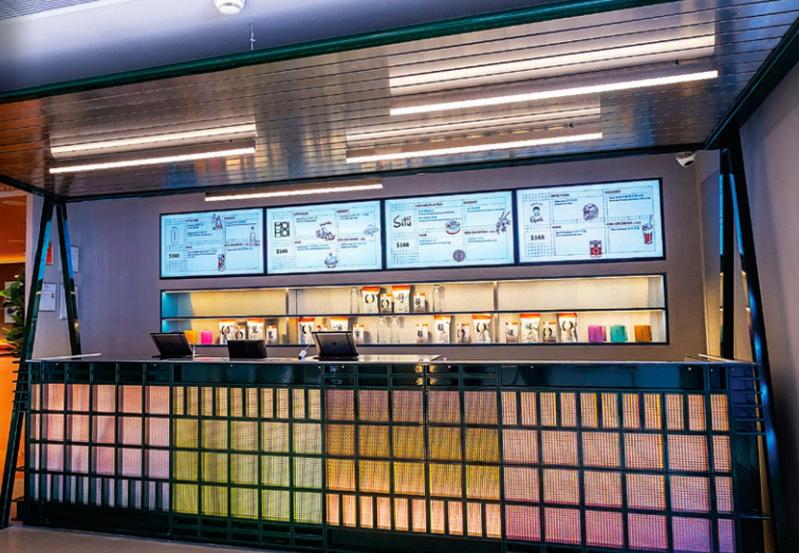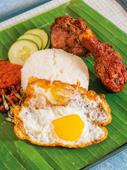 This undated file photo shows the newest food hall on Hong Kong’s horizon, J.A.M. by ZS Hospitality Group. It was Launched in Central's Nexxus Building in March. (PHOTO PROVIDED TO CHINA DAILY)
This undated file photo shows the newest food hall on Hong Kong’s horizon, J.A.M. by ZS Hospitality Group. It was Launched in Central's Nexxus Building in March. (PHOTO PROVIDED TO CHINA DAILY)
Hong Kong, long celebrated as a melting pot of East and West traditions, is known as a food lovers' paradise. Its traditional food markets are must-sees for tourists, and are daily haunts for local residents seeking fresh produce. On the other end of the spectrum is the Western-style food court dishing out prepared meals. While they have long been associated with fast food that may not be of the finest quality, no one can deny that they are convenient.
Since the pandemic began, social-distancing restrictions emptied restaurants and takeout began to dominate. Operators responded to demand by revamping food court environs into personality-driven experiences. These new food courts share the DNA of globally well-known brands such as Boston's Faneuil Hall and Florence's San Lorenzo Market.
Homage to city's food heritage
The first to emerge on the scene was Eaton HK. When AvroKO redesigned the entire hotel in 2018, the basement was split into two levels of casual food spaces. Among them The Astor on the lower floor offers a sophisticated take on the ubiquitous Asian hawker center. Sandwiched in between The Astor and the ground floor lobby is Food Hall, with each shop-in-a-shop operated by different independent brands.
Eaton HK Managing Director Dirk Dalichau grew up eating in the food courts of Europe. He counts Amsterdam's Foodhallen as a major inspiration. "Traditionally, food halls have been uninspiring, dense concentrations of food vendors, laid out without any sense of unity or style, only to offer convenient and affordable services for people looking for quick and accessible food," Dalichau said.
Hong Kong's traditional food markets are must-sees for tourists, and are daily haunts for local residents seeking fresh produce. On the other end of the spectrum is the Western-style food court dishing out prepared meals. While they have long been associated with fast food that may not be of the finest quality, no one can deny that they are convenient
"We wanted Food Hall to be a real destination for local people right in the heart of Kowloon. We envisioned a concept that would help transform the street and neighborhood, and we saw Food Hall as an opportunity to pay homage to Hong Kong's famous food scene, including street food and local food culture."
ALSO READ: Shorter menus & takeaway: Dining in the post-virus era
With each vendor offering their own branded stall, complete with unique signage, Food Hall has an eclectic ambience. Being situated within a hotel, the site comes with the promise of maintaining Eaton HK's high standards of quality and hygiene while being reasonably priced. Booth and table seating are comfortable and well-spaced around the central atrium, and every seat offers free Wi-Fi.
"You'll see school children, local workers, the elderly, vibrant members of the LGBTQ+ community and more enjoying our wide range of food, live programming from the DJ studio booth, and engaging design on any given day," Dalichau said. "You can eat a meal for as little as HK$40 (US$5)."
"Food Hall was probably the first good contemporary hall in Hong Kong, but many others followed," said Dalichau, proud of setting a trend by creating "a common eating ground for the local community ... aligning style with authenticity and affordability."
 In this undated file photo, a Chinese delicacy comprising fish maw, chicken stew and dried longan pulp is served at one of the outlets in Food Hall of Eaton HK. (PHOTO PROVIDED TO CHINA DAILY)
In this undated file photo, a Chinese delicacy comprising fish maw, chicken stew and dried longan pulp is served at one of the outlets in Food Hall of Eaton HK. (PHOTO PROVIDED TO CHINA DAILY)
Variety and flexibility
Hong Kong-based food writer Wilson Fok said that he sometimes prefers dining in food courts as opposed to restaurants. "A food court encourages choice: You can have a snack from one vendor, and a dessert or drink from another," he explained. Restaurants make better sense when people go out in a group, as it's possible to order several items from a menu while minimizing food waste, he added.
He added that not everybody has company while dining, regardless of the pandemic-induced rule of no more than four patrons to a table. And this is where the food courts score over restaurants as they "have bar tables where people feel perfectly comfortable eating alone."
Fok said he has noticed a shift both in ambience as well as the quality of the fare offered in food courts in recent years. "What used to be a gathering place for fast food is continually upgraded," he said. "Cuisines are finessed and the structure is minimized. New food courts certainly attract a wider demographic of food lovers more inclined to choose higher quality over lower price, which in turn narrows the price gap between them and restaurants."
Part of this may be attributed to millennials' preferred mode of doing things. Rather than waiting for service in stuffy restaurants with old-fashioned seating, young adults seek atmosphere - alongside robust internet connections. To them, ordering from a cashier, picking up and dropping off trays is less important than the outlet's brand, packaging and values. A brand's commitment to using sustainable containers usually earns it a bonus point.
Adapting to the new normal
Opened in mid-2020, Hongkong Land-run BaseHall took over the Jardine House two-level basement space, which had been occupied by Grappa's Cellar for decades. Designed by Linehouse to reference 1970s cinematic depictions of Hong Kong's first true skyscraper, BaseHall marks a shift from the more formal restaurants neighboring it.
BaseHall partnered with the city's trendiest food-and-beverage entrepreneurs to stack the deck toward tempting a different crowd than prior frequenters of retro concerts at Grappa's Cellar. Matt Abergel of Yardbird gets to try out a rotisserie chicken outlet with Roti Tori; Pub 1842 dispenses local brews by Young Master; and Barry Quek offers his take on Singaporean favorites with Return of Lemak.
Tom Andrews, BaseHall's project lead, acknowledged that he is personally a big fan of food halls and street market concepts around the world. "The food hall is inherently a social space where people can come together," he said. "BaseHall was designed for our local community as a convenient, high-quality destination that offers enough variety for guests to visit day in, day out."
 In this undated file photo, Nasi Lemak, created by Chef Barry Quek, is served at BaseHall’s Singaporean outlet, Return of Lemak. (PHOTO PROVIDED TO CHINA DAILY)
In this undated file photo, Nasi Lemak, created by Chef Barry Quek, is served at BaseHall’s Singaporean outlet, Return of Lemak. (PHOTO PROVIDED TO CHINA DAILY)
He pointed out that BaseHall is "designed for the vendors themselves, enabling them to incubate new ideas and reach a wide audience." While the traditional-style food court is run by a single operator, independent vendors are welcome to participate. And home delivery of BaseHall food is available as well, responding to the high demand in the wake of the pandemic.
Hong Kong-based food writer Wilson Fok said not everybody has company while dining, regardless of the pandemic-induced rule of no more than four patrons to a table. And this is where the food courts score over restaurants as they "have bar tables where people feel perfectly comfortable eating alone"
"The new food courts are great in reducing food waste, complete with environmentally friendly, biodegradable eating utensils," Fok said, alluding to BaseHall's wooden forks and paper bags. "The awareness of food waste reduction is higher in crowds that go to these food courts. Food is often served in cartons or trays that can easily be packed up to go."
Let your taste buds travel
The latest smorgasbord to officially open in March is J.A.M. by ZS Hospitality Group, on the ground floor of the Nexxus Building. Its name is short for Joint Asian Market. The space is designed by NC Design & Architecture. And the food concepts include Marmalee Market by Korean chef Song Ha-seul-lam and SiFu by dim sum chef Cheung Kin-ming.
"J.A.M. is an elevated food market offering the best local Asian flavors," said Max Lee, ZS's culinary director. "The modern interior of the space is inspired by elements found in bustling street markets around Asia, such as colorful crates and textile finishes."
Lee said he believes that while dining out is inherently a social activity, the pandemic has shifted the perception and created an enhanced need for takeouts. "When we were planning and developing the menu for J.A.M., we had this in mind and created dishes that can be both enjoyed dine-in and also travel well for take-away and delivery. We feel proud that our Asian offerings can satisfy guests who cannot travel due to the pandemic."
READ MORE: Dining, laughing & living as life goes on in Hong Kong
Fork said, "We are living in a time where food lovers value quality for money. New food courts should be equipped to inform potential customers more about their offerings - partly to justify the bigger price tag, but also to brand the venue and its products as food well made and not just (serving the need) for speed and convenience."


